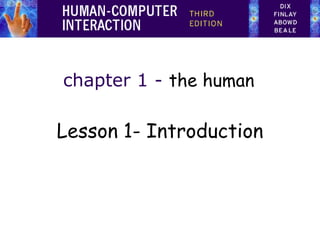
Lesson 1
- 1. chapter 1 - the human Lesson 1- Introduction
- 2. Lesson Objectives: • Discuss the human attributes which needed to computer interaction.
- 3. The Human -also known as the user, the one whom computer systems are designed to assist. -In 1983, Card, Moran and Newell described the Model Human Processor, which is simplified view of the human processing involved in interacting with computer system. -The model comprises three subsystems: • the perceptual system-handling sensory stimulus from the outside world • the motor system, which controls actions • the cognitive system, which provides the processing needed to connect the two.
- 4. Vision -Human vision is a highly complex activity with a range of physical and perceptual limitations, yet it is the primary source of information for the average person. Two stages in vision • physical reception of stimulus • processing and interpretation of stimulus
- 5. The Eye - physical reception - mechanism for receiving light and transforming it into electrical energy - light reflects from objects - images are focused upside-down on retina - retina contains rods for low light vision and cones for colour vision - ganglion cells (brain!) detect pattern and movement
- 7. The Eye – Visual reception • The information received by the visual apparatus must be filtered and passed to processing elements which allow us to recognize coherent scenes, disambiguate relative distances and differentiate color.
- 8. Interpreting the signal • Size and depth – visual angle indicates how much of view object occupies (relates to size and distance from eye) – visual acuity is ability to perceive detail (limited) – familiar objects perceived as constant size (in spite of changes in visual angle when far away) – cues like overlapping help perception of size and depth
- 10. Interpreting the signal (cont) • Brightness – subjective reaction to levels of light – affected by luminance of object – measured by just noticeable difference – visual acuity increases with luminance as does flicker • Colour – made up of hue, intensity, saturation – cones sensitive to colour wavelengths – blue acuity is lowest – 8% males and 1% females colour blind
- 11. Interpreting the signal (cont) • The visual system compensates for: – movement – changes in luminance. • Context is used to resolve ambiguity • Optical illusions sometimes occur due to over compensation
- 12. Optical Illusions the Ponzo illusion the Muller Lyer illusion
- 13. Reading • Several stages: – visual pattern perceived – decoded using internal representation of language – interpreted using knowledge of syntax, semantics, pragmatics • Reading involves saccades and fixations • Perception occurs during fixations • Word shape is important to recognition • Negative contrast improves reading from computer screen
- 14. Hearing • Provides information about environment: distances, directions, objects etc. • Physical apparatus: – outer ear – protects inner and amplifies sound – middle ear – transmits sound waves as vibrations to inner ear – inner ear – chemical transmitters are released and cause impulses in auditory nerve • Sound – pitch – sound frequency – loudness – amplitude – timbre – type or quality
- 15. Hearing (cont) • Humans can hear frequencies from 20Hz to 15kHz – less accurate distinguishing high frequencies than low. • Auditory system filters sounds – can attend to sounds over background noise. – for example, the cocktail party phenomenon.
- 16. Touch • Provides important feedback about environment. • May be key sense for someone who is visually impaired. • Stimulus received via receptors in the skin: – thermoreceptors – heat and cold – nociceptors – pain – mechanoreceptors – pressure (some instant, some continuous) • Some areas more sensitive than others e.g. fingers. • Kinethesis - awareness of body position – affects comfort and performance.
- 17. Movement • Time taken to respond to stimulus: reaction time and movement time • Movement time dependent on age, fitness etc. • Reaction time - dependent on stimulus type: – visual ~ 200ms – auditory ~ 150 ms – pain ~ 700ms • Increasing reaction time decreases accuracy in the unskilled operator but not in the skilled operator.
- 18. - Speed and accuracy of movement are important considerations in the design of interactive systems, primarily in terms of the time taken to move to a particular target on a screen.
- 19. Movement (cont) • Fitts' Law describes the time taken to hit a screen target: Mt = a + b log2(D/S + 1) where: a and b are empirically determined constants Mt is movement time D is Distance S is Size of target targets as large as possible distances as small as possible
- 20. Memory There are three types of memory function: • Sensory memories -It is used to store information which is only required fleetingly. • Short-term memory or working memory -Information is passed from sensory memory into short-term memory by attention • Long-term memory -Information is placed there from working memory through rehearsal. Selection of stimuli governed by level of arousal.
- 21. sensory memory • Buffers for stimuli received through senses – iconic memory: visual stimuli – echoic memory: aural stimuli – haptic memory: tactile stimuli • Examples – “sparkler” trail – stereo sound • Continuously overwritten
- 22. Short-term memory (STM) • Scratch-pad for temporary recall – rapid access ~ 70ms – rapid decay ~ 200ms – limited capacity - 7± 2 chunks
- 23. Examples 212348278493202 0121 414 2626 HEC ATR ANU PTH ETR EET
Editor's Notes
- =Movement time is dependent largely on the physical characteristics of the subjects: their age and fitness. =Reaction time varies according to the sensory channel through which the stimulus is received
- =Information remains in iconic memory very briefly, in the order of 0.5 seconds.